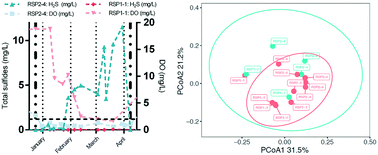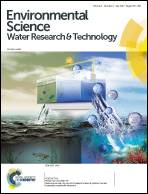Emerging investigators series: hydrogen sulfide production in municipal stormwater retention ponds under ice covered conditions: a study of water quality and SRB populations
Abstract
Stormwater retention ponds have become an integral component of stormwater management across the world. Under prolonged hypoxia, these ponds are capable of releasing large quantities of hydrogen sulfide (H2S) gas. In this study, water quality constituents and bacterial communities in sediment were analyzed in two stormwater retention ponds, RSP1 (reference pond) and RSP2 (problematic pond) over a period of two years, to identify the factors driving H2S production and understand the microbial community associated with H2S production in stormwater ponds. It was found that the background total sulfide concentrations were not statistically different between the two ponds during summer (RSP2: 0.012 ± 0.001 mg L-S−1; RSP1: 0.010 ± 0.001 mg L-S−1) and were statistically different during ice covered winter operation (RSP2: 6.375 ± 1.135 mg L-S−1; RSP1: 0.016 ± 0.009 mg L-S−1). The study showed a lack of correlation between total sulfide concentrations in RSP2 and soluble chemical oxygen demand, sulfate, soluble total phosphorus, total ammonia nitrogen, nitrate, nitrite and pH. However, DO concentrations demonstrated a strong negative correlation with total sulfides concentrations in RSP2 (p < 0.006, r = −0.58, n = 26), which confirmed DO as the critical water quality parameter linked to H2S production in stormwater ponds. Finally, it was found that seasonal change, ice covered versus non-ice covered operation and a comparison between a H2S emitting pond and non-emitting pond all did not promote a measurable proliferation of sulfate-reducing bacteria nor a community shift in the sulfate-reducing bacterial population. Hence, the study demonstrates that sulfide production is a result of increased ubiquitous SRB activity in stormwater retention ponds and the emission of H2S gas is not indicative of SRB proliferation or a population shift towards specific SRB taxa.

- This article is part of the themed collection: Emerging Investigator Series


 Please wait while we load your content...
Please wait while we load your content...